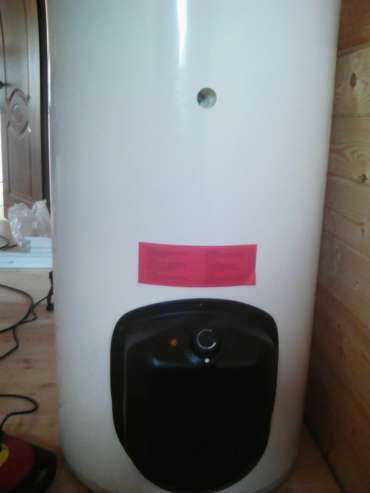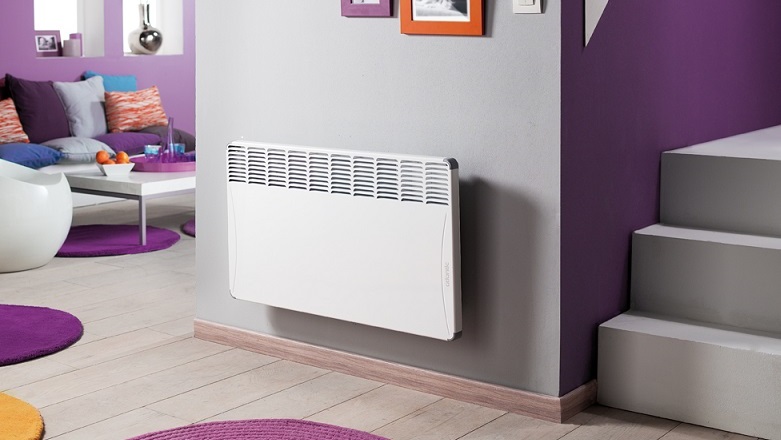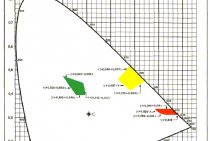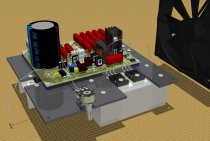Double-circuit gas boiler for heating a private house
Unlike high-rise buildings, where central heating dominates, all private houses are heated independently. Therefore, the choice of a heating device is relevant for them.
Residents of the private sector can conduct heating themselves and choose the device with which their house will be heated. Due to the saturation of the market with various products, you can choose any option that suits you.
In this article we will talk about the advantages and disadvantages of a double-circuit boiler. If your house has gas, then you can install this option, because it runs on gas.
First, let's understand what it is. This boiler has two circuits and each has its own functional purpose. The first heats the water that passes through the radiators and heats the whole house, and the second is designed to supply hot water to your home instead of a water heater or titanium.
A double-circuit boiler can have two heat exchangers, which, as a rule, are installed in a wall-mounted version. For devices with one heat exchanger, a pipe is additionally installed through which cold water is supplied.
Floor double-circuit boilers of domestic production have a primitive design. If you need to use only one circuit, then the second one will also be heated along with it. That is, in the summer you will need hot water, and when it is heated, you will heat the room. Agree that this is an extra waste of fuel and useless operation of the device.
And if in winter you use the boiler only for heating, you will always have hot water. This, of course, is better than hot batteries in the summer, but it's still useless if you don't need hot water.
Foreign-made wall-mounted boilers have independent circuits that solve the problem of floor-mounted double-circuit devices. But if one circuit fails, then the second will not work either. Currently, double-circuit wall-mounted boilers are mainly used, since they have greater efficiency than floor-standing ones.
A big plus of double-circuit boilers is their small size. If the space in your house is limited or you would not be bothered by free space, then feel free to install such a heater. Indeed, due to the combination of two functions in one unit, there is no need to install two devices: for heating and for heating water.
Double-circuit boilers are powerful enough to heat water for both heating and direct use. Their power starts from 23 kilowatts. But if you need to heat domestic water, the heating circuit is automatically turned off.
That is, for some time you will be left without hot radiators. Or water for use will be heated only in extreme cases. You can, of course, adjust the system so that you always have two circuits hot, for this you just need to prevent one of them from completely cooling down while the other is working.
Can a double-circuit boiler be used as a single-circuit hot water boiler
During the installation of heating a private house, many users face the question of choosing a boiler. Some property owners buy a double-circuit heating unit and then try to see if this appliance can be used as a single-circuit boiler. In our article we will try to answer this question in detail.
Note! The main difference between double-circuit equipment and a device for single-circuit heating is the possibility of heating the coolant for the heating system and heating the liquid for hot water supply.Water in a country house or cottage can also be heated using a single-circuit solid fuel or pellet boiler
In this case, the boiler is connected to the pipeline in close proximity to the thermal unit. In the modern construction market, of the double-circuit models, only gas units are found, so the problem with choosing a device exists only for those people who plan to use gas to heat a one-story or two-story country house. Next, we will get acquainted with the advantages and disadvantages of each model in more detail.
Water in a country house or cottage can also be heated using a single-circuit solid fuel or pellet boiler. In this case, the boiler is connected to the pipeline in close proximity to the thermal unit. In the modern construction market, of the double-circuit models, only gas units are found, so the problem with choosing a device exists only for those people who plan to use gas to heat a one-story or two-story country house. Next, we will get acquainted with the advantages and disadvantages of each model in more detail.
Single-circuit boiler
Such boiler equipment is designed to heat the coolant. Further transportation of the hot coolant occurs naturally when the water expands during heating. After installing the circulation pump in the heating system, a more uniform heating of the living rooms occurs. The pumping equipment creates pressure and directs the coolant flows to the radiators. Here, the liquid gives off part of the heat, cools and returns through the return pipeline to the heating device.
The main advantages of liquid fuel heating boilers are:
- Comparative cheapness in relation to double-circuit units, but for heating water for the needs of consumers, they buy an additional water heater, boiler;
- Ease of installation of autonomous heating of a private house;
- Single-circuit models of solid fuel heating boilers for heating a private house heat the entire volume of water in the boiler, so the user immediately receives hot water when the mixer is opened.
Important! The liquid in the water heater gradually cools over time, it needs to be heated periodically, which is the main cause of heat loss.
Features of double-circuit models of boilers
Unlike a single-circuit boiler, this unit has an additional circuit for heating hot water. Cold water is supplied to the heat exchanger of the unit from the water supply system, then the liquid is heated and supplied through the booster pump to the consumer, who opened the faucet in the kitchen or bathroom.
An important element of the equipment in question is a three-way valve. This device is connected to the boiler automation, its main task is to supply the coolant to the desired circuit
You should pay attention to the fact that the heating system does not work when the taps are turned on. In this case, the advantage of hot water supply is given, this property is usually called the priority of hot water supply
The main advantages of a double-circuit boiler are:
- low cost compared to buying a set of a boiler and a single-circuit boiler;
- compact dimensions;
- the equipment heats the right amount of water, and not the entire volume.
DHW with instantaneous water heater does not use a circulation pump. With a significant removal of the tap from the boiler, the user will have to wait some time until hot water appears. In this case, the temperature of the liquid can change while turning on the second mixer or changing the water flow.
Each model of the boiler has its own characteristics, but the installation of any unit should be carried out by an experienced master plumber. In general, a double-circuit boiler can be used as a single-circuit boiler.If you have any questions about the correct connection or installation of heating equipment, leave a request on our website or call +7 926 966 78 68
Heating convector pros and cons
One of the main questions of interest to our reader is still the aspect of the expediency of the purchase. Why a convector, and not an oil cooler for example? What power characteristics should an electric convector have? How to choose the best among the incredible range?
From a certain point of view, any equipment must contain pros and cons, the electric convector is no exception. We will start by listing the positive qualities, especially since they many times exceed the disadvantages of an electric convector.
1. The main advantage, we consider, is a technological breakthrough that allows us to design an electric convector with an efficiency of 95%. Agree, paying for electricity and getting zilch at the exit would be an unaffordable luxury. A modern convector converts electrical energy into thermal energy with maximum efficiency.
2. The low price for an average 1000 W electric convector is a strong argument in favor of the purchase.
3. Quiet operation. An electric convector does without a fan or any other mechanically moving structural elements. Silent operation is periodically disturbed by a barely audible click of a temperature sensor, which contributes to a more economical operation of the device.
4. Lack of installation and maintenance work. An electric convector is considered a household appliance, it is connected to a 220 volt network and does not require permits from government organizations. The small mass of the convector, as an additional plus, in matters of rearranging the device in a heated room
5. Built-in automation helps to maintain the required temperature in the heated room. Remote temperature sensors, made according to the type of sockets with a thermostat, additionally provide control over the temperature regime.
6. The heating element of the electric convector reaches the set temperature in a couple of minutes, starting to heat the room immediately after switching on. The temperature of the element, as a rule, does not exceed 60 ° C, preventing the heating elements from “drying” the air and “burning” oxygen. The absolute humidity of the air in the room does not change. As the temperature rises, only the relative humidity decreases slightly.
7. Not high heating temperature of the facing surfaces, provides a safe environment for people and animals to live. In addition, you do not have to worry about fire safety.
8. The service life of convectors declared by a number of manufacturers exceeds 20 years.
Electric heating convector perhaps has one minus
So you bought a convector and made sure that your wiring can withstand the extra load. The device is connected to the network, instantly starts to heat the room. As they say, there would be no price for an electric convector, if not for one BUT. The only negative, as you might have guessed, is the high cost of electricity consumed. But firstly, as we noted at the beginning of the review, the convector heats our apartment only during the off-season, and not the entire winter period.
Secondly, it is necessary to choose electric heating convectors with a thermostat, then the built-in thermostat will not allow the device to “wind the meter” around the clock. Thirdly, care should be taken to preserve heat and, if possible, reduce their loss, it is necessary to install double-glazed windows, and take care of other insulation elements.
Another minus is the smell of burning, in fact, it is not oxygen that “burns”, but settled dust on the electric heating element. To remove this drawback is as easy as shelling pears, or vacuum the convector, or simply wait for the dust to completely burn out.
What is a convector
The market offers a variety of species, where it is quite easy to get confused. An oil cooler, an electric convector, infrared radiators, the head is spinning from the assortment and price offers. We will devote our review to the electric convector. The principle of operation of the convector is based on the physical properties of heat transfer from the coolant, in our case from the heating element to the heated room with the help of internal energy, which is transmitted by jets and flows, that is, by means of convection.
In simple words, a heating element is built into the convector, which makes the air around it hot. The heated air begins to move upward, making room for cold air currents. This "cycle" is called natural convection. We hope we have answered the question of what a convector is. More clearly, with this simple process, the picture will help you figure it out:

As we can see, the electric convector has a simple principle of operation. By the way, since the movement of air is due to convection, the device does not require additional equipment with a fan, so the electric convector earns a plus in its piggy bank. Of course, this is not the only plus that makes us choose an electric heating convector to ensure a comfortable climate in our apartment, but first things first.
Electric convector calculation of kW consumption.
Agree, buying an electric convector is one thing, quite another is how much we will have to pay for the heat received, that is the question. We emphasize that our calculation of consumption is based on personal operating experience, and not on manufacturer's formulas. Let's also make it clear that we don't heat the house in a freezing winter, we raise the temperature in the room to a comfortable level. Consider an average room of 18 m2. The technical characteristics of any manufacturer, for heating a room of such an area, regulate the purchase of a 1000 W convector.
Let us clarify that in order to start the central heating, the municipal authorities are guided by the Decree of the Government of the Russian Federation of 05/06/2011 N 354., According to which, the street temperature must drop below +8 ºС and not rise for 5 days. I think many will agree that usually, in the off-season, it may take a month to achieve this goal, and the temperature outside the window is + 12 ° C, already reduces the temperature in city apartments to + 16 - 17 ° C.
Consumption calculation
Upon reaching the set value, the temperature control system will work and the consumption of electrical energy will stop. As it cools, noticeably after 20 minutes, the temperature sensor is triggered and turns on the convector again. Considering that the next switching on does not require heating from 17 °C, but starts from 20 °C, then the time to reach the value of 22 °C. much less, no more than 10 minutes. Then the on/off cycle is repeated and the average operation of the heater does not exceed 20 minutes per hour.
Actually, based on the data obtained empirically, we obtain the consumption of an electric convector. Divide 1000 watts by 60 minutes and get 16 watts - we determined the power consumption of one minute of work. In our experiment, the convector worked for no more than 20 minutes. Now we multiply 16 W by 20 minutes and we get the power that the convector used up per hour of operation - 330 W. Thus, a 1 kW convector “eats” in three hours. The cost of one kilowatt at the beginning of 2018 is 4 rubles.
Gentlemen, for the evening we will need no more than 9 hours of operation of the electric convector - 12 rubles. A month off-season will cost about 360 rubles. Let's add another 30% to this amount for reliability (for those who sit up in front of the TV). The total amount of operation of the convector will be 400 - 500 rubles for a normal temperature regime, within a month.Let me ask you a question, is it worth saving this amount, putting your body and your household at risk of cooling? Sick leave and a spoiled mood are much more expensive, drops alone from a cold can offset this kind of savings.




